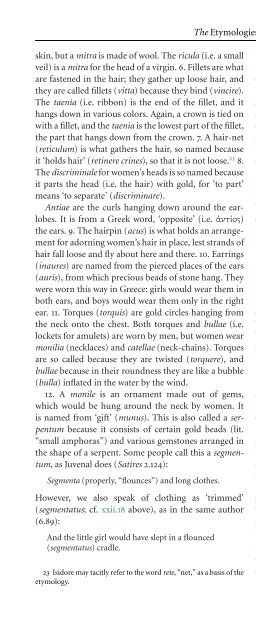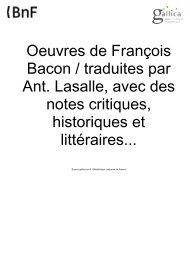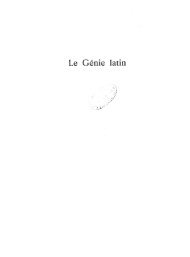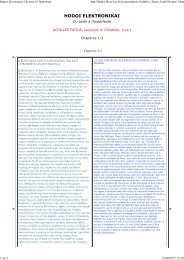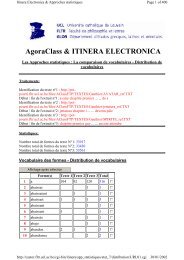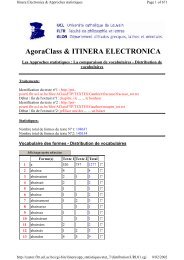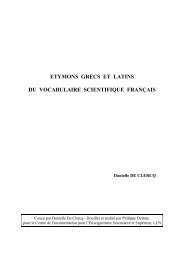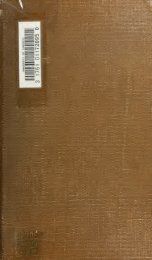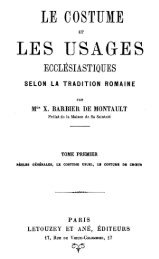The Etymologies of Isidore of Seville - Pot-pourri
The Etymologies of Isidore of Seville - Pot-pourri
The Etymologies of Isidore of Seville - Pot-pourri
You also want an ePaper? Increase the reach of your titles
YUMPU automatically turns print PDFs into web optimized ePapers that Google loves.
skin, but a mitra is made <strong>of</strong> wool. <strong>The</strong> ricula (i.e. a small<br />
veil) is a mitra for the head <strong>of</strong>avirgin.6.Fillets are what<br />
are fastened in the hair; they gather up loose hair, and<br />
they are called fillets (vitta)because they bind (vincire).<br />
<strong>The</strong> taenia (i.e. ribbon) is the end <strong>of</strong> the fillet, and it<br />
hangs down in various colors. Again, a crown is tied on<br />
withafillet,andthetaenia is the lowest part <strong>of</strong> the fillet,<br />
the part that hangs down from the crown. 7. Ahair-net<br />
(reticulum) iswhat gathers the hair, so named because<br />
it ‘holds hair’ (retinere crines), so that it is not loose. 23 8.<br />
<strong>The</strong> discriminale for women’s heads is so named because<br />
it parts the head (i.e. the hair) with gold, for ‘to part’<br />
means ‘to separate’ (discriminare).<br />
Antiae are the curls hanging down around the earlobes.<br />
It is from a Greek word, ‘opposite’ (i.e. )<br />
the ears. 9.<strong>The</strong>hairpin (acus)iswhat holds an arrangement<br />
for adorning women’s hair in place, lest strands <strong>of</strong><br />
hair fall loose and fly about here and there. 10. Earrings<br />
(inaures) arenamedfromthe pierced places <strong>of</strong> the ears<br />
(auris), from which precious beads <strong>of</strong> stone hang. <strong>The</strong>y<br />
were worn this way in Greece: girls would wear them in<br />
both ears, and boys would wear them only in the right<br />
ear. 11. Torques (torquis) are gold circles hanging from<br />
the neck onto the chest. Both torques and bullae (i.e.<br />
lockets for amulets) are worn by men, but women wear<br />
monilia (necklaces) and catellae (neck-chains). Torques<br />
are so called because they are twisted (torquere), and<br />
bullae because in their roundness they are like a bubble<br />
(bulla)inflated in the water by the wind.<br />
12. A monile is an ornament made out <strong>of</strong> gems,<br />
which would be hung around the neck by women. It<br />
is named from ‘gift’ (munus). This is also called a serpentum<br />
because it consists <strong>of</strong> certain gold beads (lit.<br />
“small amphoras”) and various gemstones arranged in<br />
the shape <strong>of</strong> a serpent. Some people call this a segmentum,asJuvenal<br />
does (Satires 2.124):<br />
Segmenta (properly, “flounces”) and long clothes.<br />
However, we also speak <strong>of</strong> clothing as ‘trimmed’<br />
(segmentatus; cf. xxii.18 above), as in the same author<br />
(6.89):<br />
And the little girl would have slept in a flounced<br />
(segmentatus) cradle.<br />
23 <strong>Isidore</strong> may tacitly refer to the word rete,“net,” as a basis <strong>of</strong> the<br />
etymology.<br />
<strong>The</strong> <strong>Etymologies</strong> XIX.xxxi.6–xxxii.2 391<br />
13. However,frequently any <strong>of</strong> a matron’s ornaments is<br />
referred to by the term munile (i.e. monile)–whichever<br />
ones are given to her as a gift (munus). 14.Amurena (lit.<br />
“eel”) is so called in common usage, because a chain <strong>of</strong><br />
aflexible kind, made <strong>of</strong> pliant tube-beads <strong>of</strong> gold metal,<br />
suitable for adorning the neck, is made in the likeness<br />
<strong>of</strong> a serpentine murena. Sometimes this is constructed<br />
from tube-beads <strong>of</strong> gold and <strong>of</strong> silver. Whence also it<br />
is said in the Song <strong>of</strong> Songs (1:10): “We will make thee<br />
chains (murenulae)<strong>of</strong>gold, inlaid with silver.”<br />
15. Catellae are chainlets (catenula)for the neck, linking<br />
to each other like chains (catena), whence they are<br />
named. 16. Bracelets (dextra, i.e. dextrale) areworn by<br />
both men and women, because both sexes wear them<br />
on the right hand (dextera). Armbands (armilla) are,<br />
properly speaking, for men (vir), conferred on soldiers<br />
in recognition <strong>of</strong> a victory for their valor (virtus)inarms<br />
(arma). For this reason they were sometimes also commonly<br />
called viriolae (perhaps read viriliae). An armilla<br />
is no different from a bracelet (circulus)inwhatitsignifies,<br />
because it also encloses something by encircling the<br />
place whereitisput,butanarmilla is more extended in<br />
depth and a circulus is rounded. 17. Fibulae (i.e. pins or<br />
brooches) are used to adorn a woman’s breast or are worn<br />
by men to holdacloak over their shoulders, or a belt<br />
around their hips. Lunulae are ornaments for women;<br />
they are small pendent gold balls shaped like the moon<br />
(luna).<br />
18. Mirrors(speculum) arewhat women use to look<br />
at their faces. A mirror is so named either because the<br />
reflection is produced from its brightness (splendor)<br />
or because women looking in it study the appearance<br />
(species) <strong>of</strong>their face and add whatever ornament they<br />
see is lacking. 19. Ankle bracelets (periscelis) areornaments<br />
for women’s legs, which adorn their appearance<br />
as they walk by. ‘Scent bottles’ (olfactoriolum) are small<br />
vessels for women, in which perfumes are carried.<br />
xxxii. Rings (De anulis) 1. Prometheusissaid to have<br />
been the first to put on his finger a circle <strong>of</strong>ironwith<br />
astone set into it; following this practice people began<br />
to wear rings. Rings (anulus)are named as a diminutive<br />
from the circlets and hoops (anus) thatgoaroundthe<br />
arms and legs. Likewise the signets (signum)<strong>of</strong>rings are<br />
as a diminutive called sigilla. Asignum is larger, and a<br />
sigillum is like a smaller signum. 2. People first began


